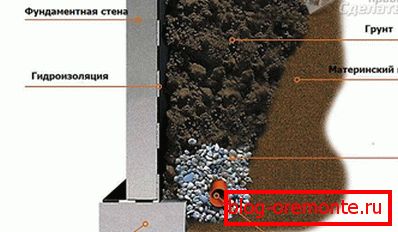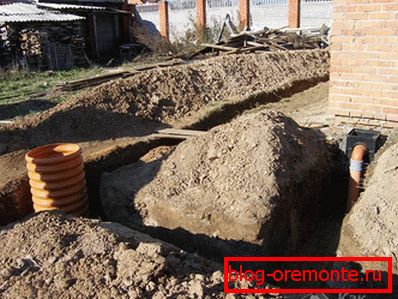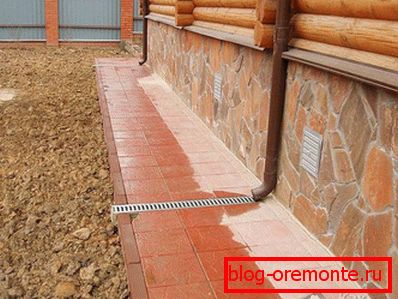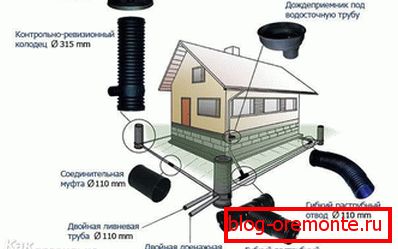How to make a foundation drainage
Starting work on the construction of the house, you need to have an idea about all stages of construction, including how to properly drain the foundation. It is the quality of the foundation that determines the reliability of the entire structure.
The drainage system is used to strengthen the base with an unfavorable type of soil, or in conditions of frequent precipitation, and there are two types:
- wall mounted;
- annular.
Wall drainage system

It is necessary for the removal of melt, groundwater and other waters and to protect the structure from their harmful effects. With a high-quality drainage installation, the building's service life is significantly increased, since it prevents the accumulation of moisture, mold and other adverse factors that lead to the destruction of the house.
Wall drainage is an angled system consisting of closed pipes. The corners of the structure are equipped with manholes. Wells are necessary to eliminate blockages that may occur during operation.
With the help of drainage, the hydrostatic and mechanical pressure of the soil water on the foundation is removed.
Ring Drainage System

This drainage system is not mounted at the surface of the walls, but at a certain distance from them (about 3 m). This drainage is used in the absence of the possibility of using the wall type and the installed blind area.
In the absence of waterproofing of walls, or the presence of reinforced concrete base is to make a choice in favor of wall drainage, otherwise you will not get the desired result.
Consequences of the lack of drainage

The presence of a drainage system is simply necessary, otherwise the impact of moisture on the base of the house will lead to its destruction. The consequences will appear gradually in the form of a skew of the walls, roof and the whole structure. That is, over time, the probability of falling home is high.
Drainage pipes

To create a drainage system, there are many materials that are sold in hardware stores. The most used are corrugated polyethylene pipes that bend well. The walls of such pipes are equipped with holes (perforations) necessary for the passage of water into them and further ingress into the sump.
The pipes are laid at a depth of 3 meters, and the service life exceeds half a century. They are mounted both before waterproofing, and after. Diameter varies from 5 to 20 cm.
If there is a large possibility of penetration of foreign particles into the pipe, and, accordingly, the probability of blockages is great, additional winding from the geopolit is required.
Geopolitical
 Geotexil has recently been rapidly gaining popularity in the construction industry. It is produced using a woven or non-woven method of polymer fibers. Since the raw material is environmentally friendly, then the final material is environmentally friendly.
Geotexil has recently been rapidly gaining popularity in the construction industry. It is produced using a woven or non-woven method of polymer fibers. Since the raw material is environmentally friendly, then the final material is environmentally friendly.
Geopolitically has a number of the following advantages:
- chemical resistance;
- no reaction resulting from thermal oxidation;
- it is not subject to rotting, a mold and fungal diseases;
- due to its structure, geopolitically protected from attacks of rodents and germination of plants.
This material is used in cases where filtration, separation, drainage and protection of the drainage system is necessary.
Independent installation of the drainage system

 Thinking about building your own house, it is necessary to provide for a drainage system, otherwise the lifetime of the structure will be minimal.
Thinking about building your own house, it is necessary to provide for a drainage system, otherwise the lifetime of the structure will be minimal.
This task should be approached with maximum responsibility and it is advisable to entrust all work to specialists. However, acquiring the necessary theoretical base, you can cope on your own.
- A sand pad is made at the bottom of the ditch;
- Installation of pipes is carried out at an angle of 1 cm per meter;
- Pipe cutting is performed with a hacksaw, then the sections are joined using a press fit and sealed the joints with glue followed by winding with insulating tape;
- Having laid and formed the pipeline, it is necessary to fill the ditch with 30 cm of a layer of small fractional gravel, then a layer of filtering geopolitna spreads;
- A non-perforated collector is installed on top of the entire structure, which is attached to the drainpipes with fittings;
- The final stage is the tamping of the upper soil layer, covering the entire structure. If there is a likelihood of abundant water flows, it is necessary to provide a gravel mound of large or medium fractions.
At this drainage works are completed, and in the future you can not worry about the security of your own home.
Video
The process of creating a foundation drainage system in video format: